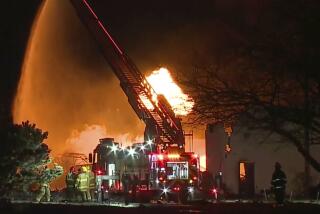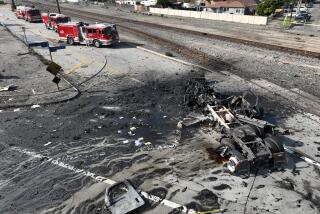Kenya gasoline blast kills at least 61
More than 60 people died Monday in a densely populated Nairobi slum after an explosion and fire caused by gasoline from a leaking pipe.
At least 116 badly burned people, many of them children, were taken to hospitals. Many were not expected to survive, as medical staff struggled with shortages of blood for transfusions.
Witnesses described a scene from hell: charred bodies strewn around the area and floating in a nearby river, where burning people had jumped into the water to extinguish flames.
Officials said 61 bodies had been recovered, with the death toll likely to rise. The Associated Press quoted officials with the International Committee of the Red Cross as saying the toll was at least 75, and local radio reports said at least 102.
The precise number of dead and their identities may never be known. Some people were so badly burned that only skeletons remained.
The blast occurred in the Sinai slum district about 9 a.m., after fuel leaked from a depot owned by Kenya Pipeline Co. and through a drain pipe into a river, residents said. At dawn, the smell of gasoline rising from the gutters sent residents scurrying for buckets and jerrycans to collect the spilled fuel.
The cause of the blast, which ignited a fire that tore through shacks in the crowded shantytown, wasn’t immediately known. Police suspected that a cigarette butt thrown near the spilled fuel may have sparked the inferno.
Children crammed into an informal school nearby were reportedly killed.
Burn victims wandered in a daze through the slum, with their skin peeling off, according to local news reports.
Jennifer Atieno, a 41-year-old resident wearing a burned sweater, said she had decided to join the throng collecting the fuel and rushed to a shop to buy jerrycans.
“Just a minute before I reached the shop, I heard a huge blast and saw heavy smoke all over the sky,” she said. “It came from the valley, and immediately I knew the fuel had caught alight.
“The blasts kept coming, and the slum caught fire,” she said. “Everybody was running in different directions, and the whole area was in total confusion. I didn’t know the fate of my house and of my neighbors, or what to do, but all I wanted was to save my soul first.”
Her house survived but was looted.
Leonard Kyalo, an unemployed 26-year-old who lost his house in the incident, said he had collected two jerrycans of gasoline and was going for more when the blasts hit. He knew the risks but went for the fuel “because of money. Times are hard. When you get a chance of getting something for food, you go for it.”
He said so much gasoline had been spilled by people carrying it away that the fire could have started anywhere.
Henry Muinde, 30, cried as he recounted how he couldn’t go for fuel himself but called his cousin, urging him not to miss such a golden opportunity. His cousin died at the scene.
There had been many leaks from the pipeline through the drainage pipe, he said, but never such a large quantity of high-quality gasoline.
Firefighters struggled to put out the blaze, scrambling over the roofs of the shacks to spray flame-retardant foam.
Prime Minister Raila Odinga, who visited the site, promised an investigation into the blast.
“What I’ve seen is shocking, terrible,” he told reporters. “This, I think, is one of the worst disasters that has happened here in this country in the oil sector.”
Oil and gasoline explosions occur frequently in some African countries, in particular oil-rich Nigeria, where oil leaks or tanker accidents attract large crowds of people to gather the spilled fuel.
Nigeria has seen many similar horrific explosions, killing dozens at a time. Two years ago, more than 120 people died in western Kenya when an overturned fuel tanker exploded.
Special correspondent Soi reported from Nairobi and Times staff writer Dixon from Johannesburg.
More to Read
Start your day right
Sign up for Essential California for news, features and recommendations from the L.A. Times and beyond in your inbox six days a week.
You may occasionally receive promotional content from the Los Angeles Times.






